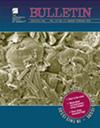华北克拉通北缘从大洋俯冲到碰撞后延伸的两阶段地壳-地幔相互作用:从古生代到中生代岩浆活动的启示
IF 3.9
1区 地球科学
Q1 GEOSCIENCES, MULTIDISCIPLINARY
引用次数: 0
摘要
在古生代晚期至中生代早期,华北克拉通北缘经历了漫长的构造-岩浆演化,以应对古亚洲洋的南下俯冲和闭合。然而,有关俯冲过程的细节以及从俯冲到碰撞后构造转变的时间仍不甚明了。在此,我们确定了乌拉山地区地壳与岩幔相互作用的两个阶段,并报告了岩浆岩的新地质年代、地球化学和Sr-Nd-Pb-Hf同位素数据,这些数据记录了古亚洲洋俯冲和闭合后的此类过程。石炭纪早期的西官井岩块具有辉长岩(约 333 Ma)和正长岩(约 331 Ma)的双峰组合。辉长岩具有类似弧的地球化学亲和性,Nb/La(0.31-0.40)和La/Ba(0.04-0.09)比值较低,Rb/Y(1.22-2.94)比值可变,Sr-Nd-Pb(87Sr/86Sri = 0.7046-0.7047; εNd(t) = -3.8 to -3.5; 206Pb/204Pbi = 17.078-17.141) 和富集到贫化的 Hf (εHf(t) = -4.5 to +6.2)同位素值。这样的地球化学特征表明,它们是由大陆下岩石圈地幔部分熔融,并由板块衍生流体变质而成的,其中有少量的星体层成分。相比之下,同时代的正长岩具有较低的εNd(t)负值(-13.5至-12.1)和εHf(t)负值(-16.3至-8.2),这表明它们是由下地壳部分熔融形成的。晚三叠世的沙德盖和西沙德盖岩体主要由含飞地的正长花岗岩组成,黑云母微晶飞地和正长花岗岩的结晶时间约为233-231Ma。黑云母微晶粒飞地的地球化学特征与石炭纪早期辉长岩相似,同时具有适度富集的同位素组成(εNd(t) = -9.7 至 -8.4;εHf(t) = -9.2 至 -0.3),这表明它们起源于地幔岩浆与上覆地壳岩浆之间的相互作用,其来源中略微加入了星体层熔融物。现场和岩石学观察结果,以及主花岗岩和岩浆微晶粒飞地的相似年龄,都表明这是一个岩浆混合过程。同位素混合模型表明,在岩浆微晶粒飞地的形成过程中,少量(10%~20%)低地壳物质被混合。寄主正长花岗岩的成分为钙碱性至碱性、金属铝至弱过铝,εNd(t)值(-15.0至-12.1)和εHf(t)值(-16.4至-9.8)均为负值,这表明它们主要来自下地壳的部分熔融,并经历了深地幔岩浆的注入。我们的新数据以及之前公布的华北克拉通北缘岩浆岩数据表明,早石炭世双峰侵入岩是在局部弧后伸展机制中形成的,该机制可能是由古亚洲洋板块后退引发的。然而,晚三叠世的侵入岩则是在板块断裂或岩石圈脱层作用下形成的碰撞后伸展机制。华北克拉通北缘岩浆活动的钕铁硼同位素时间变化表明,在古生代晚期至中生代早期,发生了从前进俯冲到后退俯冲再到后碰撞延伸的构造转换。我们提出,从俯冲到碰撞后延伸的构造转换可能发生在早三叠世-中三叠世,标志着古亚洲洋的最终关闭,这很可能发生在约250-235Ma。本文章由计算机程序翻译,如有差异,请以英文原文为准。
Two-stage crust-mantle interactions from oceanic subduction to post-collisional extension in the northern margin of the North China Craton: Insights from Paleozoic to Mesozoic magmatism
The northern margin of the North China Craton experienced prolonged tectono-magmatic evolution during the late Paleozoic−early Mesozoic in response to the southward subduction and closure of the Paleo-Asian Ocean. However, details about the subduction process and the timing of the tectonic transition from subduction to post-collision are still poorly constrained. Here, we identify two-stage crust-mantle interactions in the Wulashan area and report new geochronology, geochemistry, and Sr-Nd-Pb-Hf isotopic data for magmatic rocks that record such processes following the subduction and closure of the Paleo-Asian Ocean. The early Carboniferous Xiguanjing pluton features a bimodal suite of gabbro (ca. 333 Ma) and syenogranite (ca. 331 Ma). The gabbros have arc-like geochemical affinities, with low Nb/La (0.31−0.40) and La/Ba (0.04−0.09) ratios, and variable Rb/Y (1.22−2.94) ratios, as well as enriched, mantle-like Sr-Nd-Pb (87Sr/86Sri = 0.7046−0.7047; εNd(t) = −3.8 to −3.5; 206Pb/204Pbi = 17.078−17.141) and enriched to depleted Hf (εHf(t) = −4.5 to +6.2) isotopic values. Such geochemical signatures indicate that they were derived from partial melting of the subcontinental lithospheric mantle that was metasomatized by slab-derived fluids, with minor involvement of asthenospheric components. In contrast, the contemporaneous syenogranites are characterized by lower negative εNd(t) (−13.5 to −12.1) and εHf(t) values (−16.3 to −8.2), which suggests that they were formed by partial melting of the lower crust. Late Triassic Shadegai and Xishadegai plutons are mainly composed of enclave-bearing syenogranite, and both mafic microgranular enclaves and syenogranites crystallized at ca. 233−231 Ma. The mafic microgranular enclaves have geochemical features similar to those of the early Carboniferous gabbros, and also have moderately enriched isotopic compositions (εNd(t) = −9.7 to −8.4; εHf(t) = −9.2 to −0.3), which suggests that they originated from interaction between mantle-derived magma and overlying crust-derived magma, with minor additions of asthenospheric melts in their sources. Field and petrological observations, coupled with the similar ages of the host granites and mafic microgranular enclaves, suggest a magmatic mingling process. Isotopic mixing models suggest that minor amounts (∼10%−20%) of lower crustal materials were mixed during the formation of the mafic microgranular enclaves. The host syenogranites display calc-alkaline to alkalic and metaluminous to weakly peraluminous compositions, and negative εNd(t) (−15.0 to −12.1) and εHf(t) values (−16.4 to −9.8), which indicates that they were mainly derived from partial melting of the lower crust and experienced the injection of deep mantle-derived magmas. Our new data, along with previously published data for magmatic rocks in the northern margin of the North China Craton, suggest that the early Carboniferous bimodal intrusive rocks formed in a localized back-arc extensional regime that was probably triggered by slab rollback of the Paleo-Asian Ocean. However, the Late Triassic plutons formed in a post-collisional extensional regime in response to slab breakoff or lithospheric delamination. Temporal variations of Nd-Hf isotopes for the magmatism in the northern margin of the North China Craton suggest that tectonic switching from advancing to retreating subduction to post-collisional extension occurred during the late Paleozoic to early Mesozoic. We propose that a tectonic transition from subduction to post-collisional extension may have occurred during the Early−Middle Triassic, marking the final closure of the Paleo-Asian Ocean, which most likely took place at ca. 250−235 Ma.
求助全文
通过发布文献求助,成功后即可免费获取论文全文。
去求助
来源期刊

Geological Society of America Bulletin
地学-地球科学综合
CiteScore
9.30
自引率
8.20%
发文量
159
审稿时长
4-8 weeks
期刊介绍:
The GSA Bulletin is the Society''s premier scholarly journal, published continuously since 1890. Its first editor was William John (WJ) McGee, who was responsible for establishing much of its original style and format. Fully refereed, each bimonthly issue includes 16-20 papers focusing on the most definitive, timely, and classic-style research in all earth-science disciplines. The Bulletin welcomes most contributions that are data-rich, mature studies of broad interest (i.e., of interest to more than one sub-discipline of earth science) and of lasting, archival quality. These include (but are not limited to) studies related to tectonics, structural geology, geochemistry, geophysics, hydrogeology, marine geology, paleoclimatology, planetary geology, quaternary geology/geomorphology, sedimentary geology, stratigraphy, and volcanology. The journal is committed to further developing both the scope of its content and its international profile so that it publishes the most current earth science research that will be of wide interest to geoscientists.
 求助内容:
求助内容: 应助结果提醒方式:
应助结果提醒方式:


